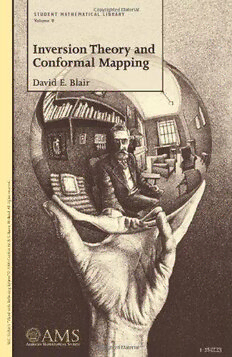
Inversion theory and conformal mapping PDF
Preview Inversion theory and conformal mapping
STUDENT MATHEMATICAL LIBRARY Volume 9 Inversion Theory and Conformal Mapping David E. Blair d. ve hts reser g All ri d. n olla H n- Baar V.- B. Art n o d or C 0 0 0 2 © ” here p g S n fl ecti Re h wit d n Ha “ her’s Esc C. M. Selected Titles in This Series Volume 9 David E. Blair Inversion theory and conformal mapping 2000 8 Edward B. Burger Exploring the number jungle: A journey into diophantine analysis 2000 7 Judy L. Walker Codes and curves 2000 6 G´erald Tenenbaum and Michel Mend`es France The prime numbers and their distribution 2000 5 Alexander Mehlmann The game’s afoot! Game theory in myth and paradox 2000 4 W. J. Kaczor and M. T. Nowak Problems in mathematical analysisI: Real numbers, sequences and series 2000 3 Roger Knobel An introduction to the mathematical theory of waves 2000 2 Gregory F. Lawler and Lester N. Coyle Lectures on contemporary probability 1999 1 Charles Radin Miles of tiles 1999 STUDENT MATHEMATICAL LIBRARY Volume 9 Inversion Theory and Conformal Mapping David E. Blair Editorial Board David Bressoud Carl Pomerance Robert Devaney, Chair Hung-Hsi Wu 2000 Mathematics Subject Classification. Primary 26B10, 30–01, 30C99, 51–01,51B10, 51M04, 52A10, 53A99. Cover art: M. C. Escher, “Hand with Reflecting Sphere”, (cid:2)c 2000 Cor- don Art B. V.-Baarn-Holland. All rights reserved. Aboutthecover: ThepictureonthecoverisM.C.Escher’s“Handwith Reflecting Sphere”, a self-portrait of the artist. Reflection (inversion) in a sphere is a conformal map; thus, while distances are distorted, angles are preserved and the image is recognizable. It is for this reason that we commonlyusesphericalmirrors,e.g.therighthandrearviewmirroronan automobile. Library of Congress Cataloging-in-Publication Data Blair,DavidE.,1940– Inversiontheoryandconformalmapping/DavidE.Blair. p.cm. —(Studentmathematicallibrary,ISSN1520-9121;v.9) Includesbibliographicalreferencesandindex. ISBN0-8218-2636-0(softcover: alk.paper) 1.Inversions(Geometry) 2.Conformalmapping. I.Title. II.Series. QA473.B57 2000 516.3(cid:2)6—dc21 00-033137 Copying and reprinting. Individual readers of this publication, and nonprofit libraries acting for them, are permitted to make fair use of the material, such as to copy a chapter for use in teaching or research. Permission is granted to quote brief passagesfromthispublicationinreviews,providedthecustomaryacknowledgmentof thesourceisgiven. Republication,systematiccopying,ormultiplereproductionofanymaterialinthis publicationispermittedonlyunderlicensefromtheAmericanMathematicalSociety. Requests for such permission should be addressed to the Assistant to the Publisher, AmericanMathematicalSociety,P.O.Box6248,Providence,RhodeIsland02940-6248. [email protected]. (cid:2)c 2000bytheAmericanMathematicalSociety. Allrightsreserved. TheAmericanMathematicalSocietyretainsallrights exceptthosegrantedtotheUnitedStatesGovernment. PrintedintheUnitedStatesofAmerica. (cid:2)∞ Thepaperusedinthisbookisacid-freeandfallswithintheguidelines establishedtoensurepermanenceanddurability. VisittheAMShomepageatURL:http://www.ams.org/ 10987654321 050403020100 To Marie and Matthew Contents Preface ix Chapter 1. Classical Inversion Theory in the Plane 1 §1.1. Definition and basic properties 1 §1.2. Cross ratio 9 §1.3. Applications 14 §1.4. Miquel’s Theorem 17 §1.5. Feuerbach’s Theorem 21 Chapter 2. Linear Fractional Transformations 27 §2.1. Complex numbers 27 §2.2. The extended complex plane and stereographic projection 29 §2.3. Linear fractional transformations 34 §2.4. Cross ratio 37 §2.5. Some special linear fractional transformations 39 §2.6. Extended M¨obius transformations 43 §2.7. The Poincar´e models of hyperbolic geometry 52 vii viii Contents §2.8. A distortion theorem 59 Chapter 3. Advanced Calculus and Conformal Maps 63 §3.1. Review of advanced calculus 63 §3.2. Inner products 70 §3.3. Conformal maps 73 Chapter 4. Conformal Maps in the Plane 75 §4.1. Complex function theory 75 §4.2. Abundance of conformal maps 78 Chapter 5. Conformal Maps in Euclidean Space 83 §5.1. Inversion in spheres 83 §5.2. Conformal maps in Euclidean space 87 §5.3. Sphere preserving transformations 92 Chapter 6. The Classical Proof of Liouville’s Theorem 95 §6.1. Surface theory 95 §6.2. The classical proof 103 Chapter 7. When Does Inversion Preserve Convexity? 107 §7.1. Curve theory and convexity 107 §7.2. Inversion and convexity 110 §7.3. The problem for convex bodies 114 Bibliography 115 Index 117 Preface Itis rarelytaught inanundergraduate, orevengraduate, curriculum thattheonlyconformalmapsinEuclideanspaceofdimensiongreater than 2 are those generated by similarities and inversions (reflections) in spheres. This contrasts with the abundance of conformal maps in the plane, a fact which is taught in most complex analysis courses. Theprincipal aimofthistextistogiveatreatmentofthispaucityof conformal maps in higher dimensions. The result was proved in 1850 in dimension 3 by J. Liouville [22]. In Chapter 5 of the present text we give a proof in general dimension due to R. Nevanlinna [26] and in Chapter 6 give a differential geometric proof in dimension 3 which is often regarded as the classical proof, though it is not Liouville’s proof. For completeness, in Chapter 4 we develop enough complex analysis to prove the abundance of conformal maps in the plane. Inadditionthisbookdevelopsinversiontheoryasasubjectalong with the auxiliary theme of “circle preserving maps”. Thetextaspresentedhereisattheadvancedundergraduatelevel and is suitable fora“capstone course”, topicscourse, seniorseminar, independent study, etc. The author has successfully used this mate- rialforcapstonecoursesatMichiganStateUniversity. Oneparticular feature is the inclusion of the paper on circle preserving transforma- tions by C. Carath´eodory [6]. This paper divides itself up nicely into small sections, and students were asked to present the paper to the ix
